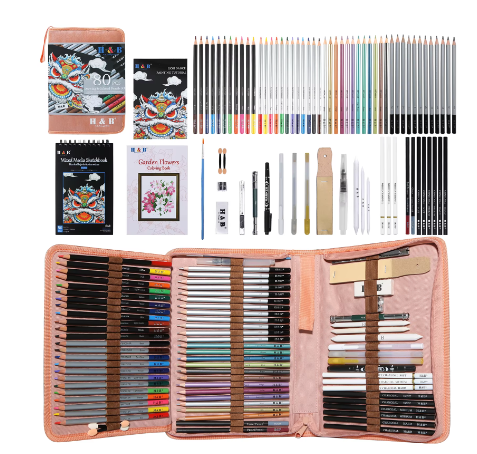Precision and Control in Detailed Artwork
Sharp Points for Fine Line Work
High-quality Drawing Pencils are designed to maintain sharp points, crucial for creating fine and intricate lines. This sharpness allows artists to work with precision, essential for detailed work such as illustration, technical drawing, and sketching. Through superior point retention, these pencils eliminate the frequent need for sharpening, thus boosting efficiency in projects where time and meticulous detail are of the essence. An artist commented, "The ability to produce consistently sharp lines gives not just improvement in speed but elevates the quality of the entire artwork." This underscores the critical role sharp points play in producing detailed artwork and achieving fine line work consistently.
Consistent Lead Composition
High-quality pencils are distinguished by their consistent lead composition, ensuring uniform application and performance during use. This consistency leads to smoother lines and minimizes variations in texture and density, significantly enhancing the overall artistry. The quality of the lead affects both the feel of the pencil in-hand and the artist's control over shading and intricate detail. The consistent composition of the lead lends itself to the reliability that artists seek when producing fine details. One artist mentioned, "Having a pencil with consistent lead quality means my lines are predictable, allowing for controlled shading and perfect detail, especially in complex areas of artwork." Thus, the consistent lead composition of quality pencils is a key factor in achieving precision in artwork.
Durability Advantages of Professional-Grade Pencils
Reduced Breakage and Longevity
Professional-grade pencils offer significant advantages in terms of durability, which is crucial for artists working on intensive projects. These pencils are crafted to withstand pressure and resist breakage, ensuring they last longer than their lower-grade counterparts. The resilience provided by high-quality materials makes these pencils a lasting investment for any artist. Research shows that artists using durable pencils experience fewer interruptions due to breakage, thereby boosting their productivity. This durability allows artists to focus more on their creative processes rather than dealing with frequent pencil breakages.
Cost-Effectiveness Over Time
Although professional-grade pencils may have a higher upfront cost, they prove to be cost-effective in the long run. Their superior durability reduces the frequency of replacement, which can significantly lower overall art supply costs. According to industry statistics, artists save approximately 20-30% over several months when opting for high-quality tools. This saving underscores the value of investing in professional-grade pencils, which not only offer longevity but also provide consistent performance and enhance the overall quality of artwork.
Mastering Graphite Grades for Artistic Expression
H vs. B: Understanding Tone and Texture
Understanding the difference between H (hard) and B (black) grades is crucial for achieving the desired tonal quality in art. Graphite pencils come in a range of grades that offer unique properties for artists. H pencils, known for their hard, light strokes, are ideal for fine lines and detailed work. Conversely, B pencils have softer leads, perfect for rich, dark shading, adding depth and contrast to your sketches. Expert artists often note that mastering these graphite grades not only enhances tonal range but also allows for greater control over textures. This understanding is fundamental for anyone looking to expand their artistic horizon and improve the quality of their work.
Choosing Grades for Shading vs. Sketching
Selecting the appropriate graphite grade is essential depending on whether you're shading or sketching. Softer grades like 4B, 6B, or even 9B are encouraged for shading, as they offer increased fluidity and richness in darker tones. In contrast, harder pencils like 2H or 4H are suited for quick sketches, especially when fine, precise lines are required. The impact of the right grading choice extends beyond aesthetics, affecting the technical aspects of the piece, such as depth and dynamics. Seasoned artists often provide guidance through tutorials and workshops, showing how blending techniques vary with different grades. This practical knowledge helps artists optimize their technique, particularly when blending or layering different shades.
Superior Blending and Layering Capabilities
Smudging Techniques for Realistic Depth
High-quality pencils are vital for achieving effective smudging techniques, which are essential to creating shadows and depth in artwork. Their superior composition allows artists to blend colors seamlessly, resulting in more authentic and realistic depictions. This blendability is crucial for transitioning smoothly between colors and adding dimension, without which artwork may appear flat and unrealistic. Numerous tutorials emphasize the transformative power of proper blending, teaching aspiring artists how to utilize these techniques to elevate their work to a professional level.
Paper Interaction and Tonal Range
The quality of paper significantly impacts how effectively pencils can blend and layer, which is why choosing the right art supplies is so crucial. Premium drawing pencils paired with the appropriate paper can produce a wider tonal range, thus enriching artistic expression. Research indicates that artists using high-quality pencils and paper achieve greater depth and detail in their work. The interaction between pencil and paper texture is pivotal; for instance, rough paper allows for more extensive blending, while smoother paper provides more precise details. Therefore, understanding and leveraging these interactions can greatly enhance an artist's potential for creative expression.
Elevating Art Quality with Premium Materials
Impact on Professional Presentation
Using high-quality drawing pencils has a profound impact on the overall presentation of artwork, significantly enhancing its aesthetic appeal. The superior finish that these pencils provide can make a noticeable difference in how artwork is perceived, especially in professional settings such as portfolios or exhibitions. Many artists find that when they switch to professional-grade materials, they receive improved feedback and recognition for their work. These tools help portray their art with a precision and finish that can't be matched by lower-grade alternatives, thereby increasing their artwork's value and its appeal to critics and fans alike.
Building Confidence Through Reliable Tools
High-quality pencils not only enhance the final output of artwork but also boost the confidence levels of artists by offering consistency and reliability. When working with inferior materials, artists may face frustration due to breakages or lack of uniformity in lines, which can stifle creativity. However, reliable tools streamline the creative process, reducing distractions and allowing artists to focus entirely on their work. Testimonials from satisfied artists frequently highlight how premium tools help them express their ideas more freely and push the boundaries of their creative capabilities, fostering greater innovation in their artistic journey.
FAQ
Why are high-quality pencils preferred for detailed artwork?
High-quality pencils maintain sharp points and have consistent lead composition, allowing for precision in detailed work and consistent performance, ensuring smoother lines and minimal texture variations.
Are professional-grade pencils cost-effective despite their higher initial cost?
Yes, professional-grade pencils are cost-effective over time due to their durability, reducing frequent replacements and overall art supply costs by approximately 20-30% over several months.
How does understanding graphite grades enhance artistic expression?
Graphite grades, such as H and B, provide unique properties that help artists achieve desired tonal quality, control over textures, and in selecting appropriate grades for shading or sketching, enhancing depth and dynamics in artwork.
What role do paper quality and blending techniques play in artwork?
High-quality paper paired with premium pencils allows for superior blending and layering capabilities, expanding tonal range and enriching artistic expression, as paper texture significantly impacts blending methods.


